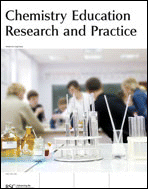Using word associations for assessing non major science students’ knowledge structure before and after general chemistry instruction: the case of atomic structure
Abstract
Determining students’ knowledge structure is important for assessing what a learner knows about a domain of knowledge. Traditional assessment methods are not always appropriate for exploring students’ knowledge structure and changes during the learning period. This study investigates how the existing knowledge structure of the learners interacts with content knowledge to produce a new knowledge structure relating to atomic theories, and whether a word association test (WAT) could be used to assess changes in students’ knowledge structure. Participants’ (40 elementary science education minors enrolled in a general chemistry class) knowledge structure was examined using WAT before and following a unit of instruction on atomic theories. In order to map the structures, relatedness coefficient values and response frequencies were used. When the maps obtained from these methods were examined it was seen that both had limitations. For this reason a new/different mapping technique was developed and used. It showed that the differences in the students’ knowledge structures before and after instruction make it clear that instruction had affected the knowledge structure.

 Please wait while we load your content...
Please wait while we load your content...